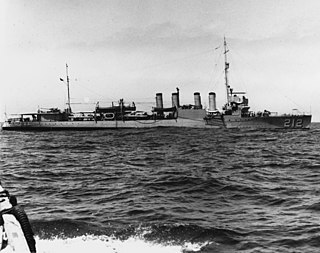
The United States Asiatic Fleet was a fleet of the United States Navy during much of the first half of the 20th century. Before World War II, the fleet patrolled the Philippine Islands. Much of the fleet was destroyed by the Japanese by February 1942, after which it was dissolved, and the remnants incorporated into the naval component of the South West Pacific Area command, which eventually became the Seventh Fleet.

Fleet Week is a United States Navy, United States Marine Corps, and United States Coast Guard tradition in which active military ships recently deployed in overseas operations dock in a variety of major cities for one week. Once the ships dock, the crews can enter the city and visit its tourist attractions. At certain hours, the public can take a guided tour of the ships. Often, Fleet Week is accompanied by military demonstrations and air shows such as those provided by the Blue Angels.

USS Mahan (DD-102) was a Wickes-class destroyer built for the United States Navy. Commissioned in 1918, Mahan was a flush deck destroyer, and the first ship to be named for Rear Admiral Alfred Thayer Mahan. Her main battery consisted of four 4-inch/50 caliber guns.

The first USS Walker (DD-163) was a Wickes-class destroyer that saw service in the United States Navy during World War I. She was named for Admiral John Grimes Walker.

Montgomery Meigs Taylor was an admiral in the United States Navy. He served in the Navy from 1890 to 1933, fought in the Battle of Manila Bay during the Spanish–American War in 1898, and later commanded the Control Fleet and the Scouting Fleet. He served as commander-in-chief of the United States Asiatic Fleet from 1931 to 1933.

USS S-19 (SS-124) was a first-group S-class submarine of the United States Navy. She was in commission from 1921 to 1922 and from 1923 to 1934 and served in both the Atlantic and Pacific Oceans.

USS Smith Thompson (DD-212) was a Clemson-class destroyer in service with the United States Navy from 1919 to 1936. She was intentionally sunk following a collision with USS Whipple (DD-217), in July 1936.

USS Barker (DD-213) was a Clemson-class destroyer in the United States Navy in World War II, named for Admiral Albert S. Barker.

USS Bulmer (DD-222/AG-86) was a Clemson-class destroyer in the United States Navy during World War II. It was the last warship of the Asiatic Fleet in USN commission.

USS Stewart (DD-224) was a Clemson-class destroyer in the United States Navy during World War II. She was the second ship named for Rear Admiral Charles Stewart. Scuttled in port at Surabaya, Java, she was later raised by the Japanese and commissioned as Patrol Boat No. 102. She came back under American control in 1945 after the occupation of Japan.

USS Pillsbury (DD-227) was a Clemson-class destroyer of the United States Navy that served during World War II and the first of two ships named after John E. Pillsbury, a Rear Admiral in the United States Navy. She was sunk by Japanese cruisers, approximately 200 miles east of Christmas Island on or around 2 March 1942 with all hands, one of two major American surface warships lost in World War II with no survivors.

USS Hulbert (DD-342/AVD-6) was a Clemson-class destroyer in the United States Navy following World War I. She was named for Henry Hulbert.

USS Sicard (DD-346/DM-21/AG-100) was a United States Navy Clemson-class destroyer in commission from 1920 to 1945. She was service during World War II. She was named for Rear Admiral Montgomery Sicard.
Destroyer minesweeper was a designation given by the United States Navy to a series of destroyers that were converted into high-speed ocean-going minesweepers for service during World War II. The hull classification symbol for this type of ship was "DMS." Forty-two ships were so converted, beginning with USS Dorsey (DD-117), converted to DMS-1 in late 1940, and ending with USS Earle (DD-635), converted to DMS-42 in mid-1945. The type is now obsolete, its function having been taken over by purpose-built ships, designated as "minesweeper (high-speed)" with the hull classification symbol MMD.

Claiborne Jay Walker was an American fencer and naval Lieutenant. Walker competed in the individual and team sabre events at the 1920 Summer Olympics. Walker entered the United States Naval Academy in 1917 where he received various awards as a fencer. Walker died aged 27 of a gunshot wound while serving overseas in Shanghai, China.
The Destroyermen series is a series of alternate history books, written by American writer and historian Taylor Anderson. The fifteen books in the series are Into the Storm, Crusade, Maelstrom (2009), Distant Thunders (2010), Rising Tides, Firestorm, Iron Gray Sea (2012), Storm Surge (2013), Deadly Shores (2014), Straits of Hell (2015), Blood in the Water (2016), Devil's Due (2017), River of Bones (2018), Pass of Fire (2019), and Winds of Wrath (2020).

Maelstrom is the third book of the Destroyermen series by author Taylor Anderson.

Crusade is the second book of the Destroyermen series. Matthew Reddy, and the crew of USS Walker, are reunited with the destroyer USS Mahan, and set out to fight the Grik. Reddy and Walker's marine detachment, continue training the Lemurians to defend themselves and take the war to the Grik. The Grik have now taken over the ship that was chasing them, the Japanese battlecruiser Amagi.
Taylor Anderson is an author, historical artillery and firearm expert, re-enactor, and former history professor. He is the author of the Destroyermen series, about USS Walker, USS Mahan, and USS S-19, and their fight against the Grik. Anderson has also written several short stories in the same fictional universe.

Rising Tides is the fifth book of the Destroyermen series of alternate history novels by Taylor Anderson.

















